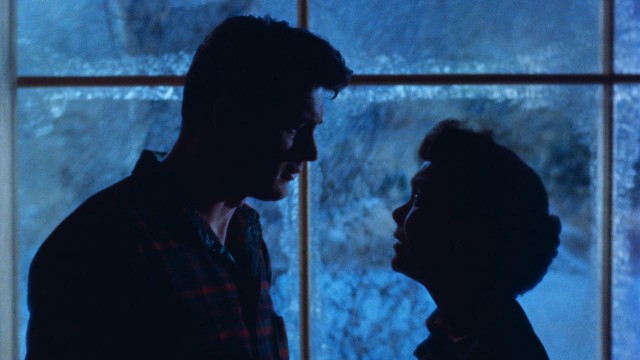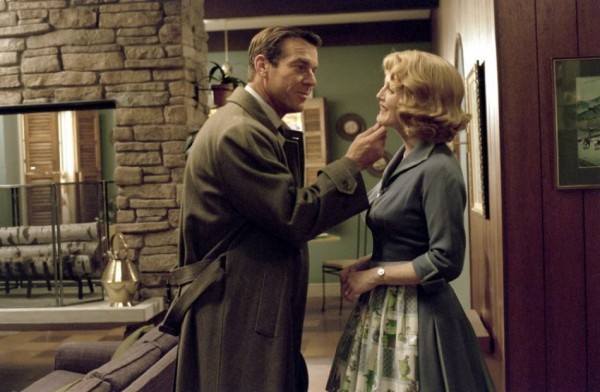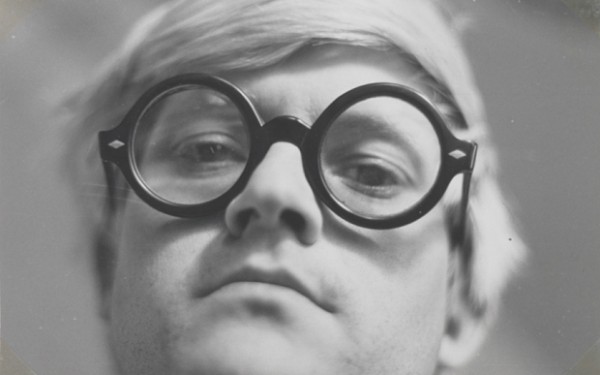
Documentary celebrates the life and career of British artist David Hockney
HOCKNEY (Randall Wright, 2015)
Metrograph, 7 Ludlow St. between Canal & Hester Sts., 212-660-0312
Film Society of Lincoln Center, Francesca Beale Theater, Walter Reade Theater,
West 65th St. between Amsterdam Ave. & Broadway
Opens Friday, April 22
hockneyfilm.tumblr.com
 “Why are you popular?” artist David Hockney is asked in an old interview in the 2014 documentary Hockney. “I’m not that sure,” the painter and photographer answers with a laugh. “I’m interested in ways of looking, because people will respond. Everybody does look; it’s just a question of how hard.” Award-winning director Randall Wright, who in 2002 made David Hockney: Secret Knowledge, examining the artist’s theories about the use of cameras and photographic-like visualization techniques in art going back centuries, this time takes a loving, more wide-ranging look at Hockney’s professional and personal worlds. Combining new interviews with old footage and home movies and photographs from Hockney’s private archives — which have never been made public before — Wright reveals Hockney to be an absolutely charming and engaging man with a genuine passion for life but not without his demons. “The paintings all related, whether superficially or intensely, on his life, and his trying to deal with his homosexuality, and trying to deal with his fantasies, and trying to deal with the issues of a sexual identity,” fellow British artist and longtime Hockney friend Mark Berger explains. “And he used wit to play with these identities. He was really like a little high school girl about it.” Wright and cinematographer Patrick Duval insert beautiful shots of many of Hockney’s paintings, slowly moving over the canvases as Hockney and, often, the subjects being depicted discuss them. Among the glorious works shown, from portraits and realistic paintings to more experimental, surreal, and abstract pieces, are “A Bigger Splash,” “Portrait of My Father,” “Christopher Isherwood and Don Bachardy,” “We Two Boys Together Clinging Together,” “Picture of a Hollywood Swimming Pool,” “Beverly Hills Housewife,” “Celia with a Foot on a Chair,” and such Polaroid composites as “Still Life Blue Guitar 4th April 1982.”
“Why are you popular?” artist David Hockney is asked in an old interview in the 2014 documentary Hockney. “I’m not that sure,” the painter and photographer answers with a laugh. “I’m interested in ways of looking, because people will respond. Everybody does look; it’s just a question of how hard.” Award-winning director Randall Wright, who in 2002 made David Hockney: Secret Knowledge, examining the artist’s theories about the use of cameras and photographic-like visualization techniques in art going back centuries, this time takes a loving, more wide-ranging look at Hockney’s professional and personal worlds. Combining new interviews with old footage and home movies and photographs from Hockney’s private archives — which have never been made public before — Wright reveals Hockney to be an absolutely charming and engaging man with a genuine passion for life but not without his demons. “The paintings all related, whether superficially or intensely, on his life, and his trying to deal with his homosexuality, and trying to deal with his fantasies, and trying to deal with the issues of a sexual identity,” fellow British artist and longtime Hockney friend Mark Berger explains. “And he used wit to play with these identities. He was really like a little high school girl about it.” Wright and cinematographer Patrick Duval insert beautiful shots of many of Hockney’s paintings, slowly moving over the canvases as Hockney and, often, the subjects being depicted discuss them. Among the glorious works shown, from portraits and realistic paintings to more experimental, surreal, and abstract pieces, are “A Bigger Splash,” “Portrait of My Father,” “Christopher Isherwood and Don Bachardy,” “We Two Boys Together Clinging Together,” “Picture of a Hollywood Swimming Pool,” “Beverly Hills Housewife,” “Celia with a Foot on a Chair,” and such Polaroid composites as “Still Life Blue Guitar 4th April 1982.”
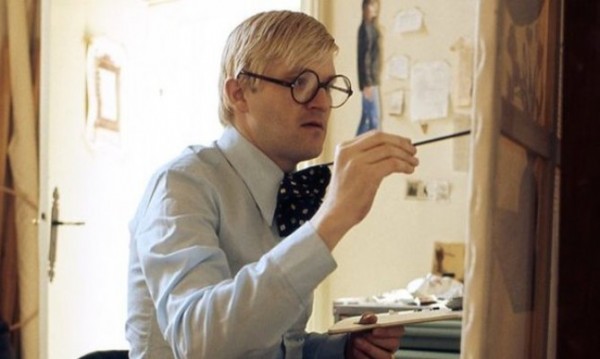
David Hockney opens up his personal archives for illuminating documentary
The film reveals Hockney to be a Warholian-like figure with a much more open and fun-loving personality — complete with odd glasses, bottle-blonde hair with bangs, and a love of photography — enjoying the party life as he goes from his hometown, “dingy Bradford” in England, to New York and Los Angeles; he currently lives in England and California and still paints seven days a week at the age of seventy-eight. It’s quite a thrill to see Hockney at work in his studios, putting brush to canvas. “I paint what I like and when I like” is one of numerous Hockney quotes that Wright uses on title cards, setting them on different monochrome backgrounds and interspersing them throughout the film. Wright (Lucian Freud: A Painted Life) also explores in-depth Hockney’s relationships with such friends and/or lovers as Peter Schlesinger and Henry Geldzahler. One drawback is that the director identifies his interview subjects, Hockney’s friends, colleagues, and relatives, only by name, so it is not always clear what their relationship to the artist is; most viewers are not likely to know who Bachardy, Arthur Lambert, Tchaik Chassay, Melissa North, Wayne Sleep, John Kasmin, or even Ed Ruscha and Jack Larson are or how Margaret Hockney is related to David. (Larson is the recently deceased actor who played Jimmy Olsen on the Superman television series and became a collector of Hockney’s work, while Margaret is David’s sister.) But that’s only a minor quibble in a wonderful documentary that celebrates not only the artist but his work and process, which comes alive on the screen, digital technology allowing the paintings and photographs to pop with their brilliant colors. If you didn’t appreciate Hockney’s talent before, this documentary will change your mind about it. And if you already were a fan of him and his work, this film will make you love him even more.
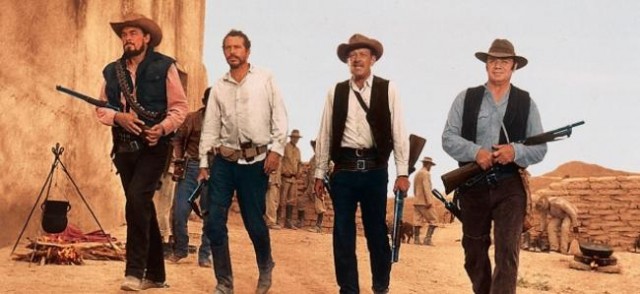
 Sam Peckinpah cemented his reputation for graphic violence and eclectic storytelling with the genre-redefining 1969 Western The Wild Bunch. When a robbery goes seriously wrong, Pike Bishop (William Holden), Dutch Engstrom (Ernest Borgnine), Freddie Sykes (Edmond O’Brien), Angel (Jaime Sánchez), and brothers Lyle (Warren Oates) and Tector Gorth (Ben Johnson) set out to get even, planning an even bigger score by going after a U.S. Army weapons shipment on a railroad protected by detective Pat Harrigan (Albert Dekker) and his hired gun, Deke Thornton (Robert Ryan), who is given nothing but “egg-suckin’, chicken-stealing gutter trash” to work with, including the hapless Coffer (Strother Martin) and T.C. (L. Q. Jones). The aging Pike, who sees this as his last score, is worried about being in cahoots with the unpredictable General Mapache (Emilio Fernández), a local warlord battling Pancho Villa’s freedom forces. But at the center of the film is the cat-and-mouse game between Pike and Thornton, the latter determined to capture his former partner, who left him to rot in jail years earlier. It all comes to a head in Agua Verde, which might translate to “Green Water” but will soon be bathed in red blood in one of the most violent shoot-outs ever depicted on celluloid.
Sam Peckinpah cemented his reputation for graphic violence and eclectic storytelling with the genre-redefining 1969 Western The Wild Bunch. When a robbery goes seriously wrong, Pike Bishop (William Holden), Dutch Engstrom (Ernest Borgnine), Freddie Sykes (Edmond O’Brien), Angel (Jaime Sánchez), and brothers Lyle (Warren Oates) and Tector Gorth (Ben Johnson) set out to get even, planning an even bigger score by going after a U.S. Army weapons shipment on a railroad protected by detective Pat Harrigan (Albert Dekker) and his hired gun, Deke Thornton (Robert Ryan), who is given nothing but “egg-suckin’, chicken-stealing gutter trash” to work with, including the hapless Coffer (Strother Martin) and T.C. (L. Q. Jones). The aging Pike, who sees this as his last score, is worried about being in cahoots with the unpredictable General Mapache (Emilio Fernández), a local warlord battling Pancho Villa’s freedom forces. But at the center of the film is the cat-and-mouse game between Pike and Thornton, the latter determined to capture his former partner, who left him to rot in jail years earlier. It all comes to a head in Agua Verde, which might translate to “Green Water” but will soon be bathed in red blood in one of the most violent shoot-outs ever depicted on celluloid.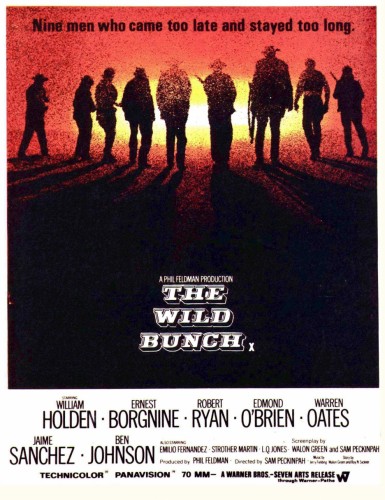
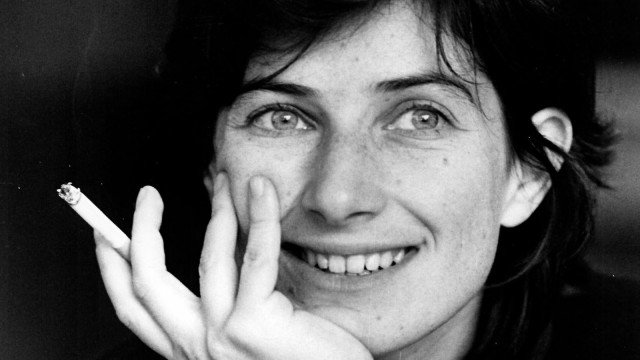
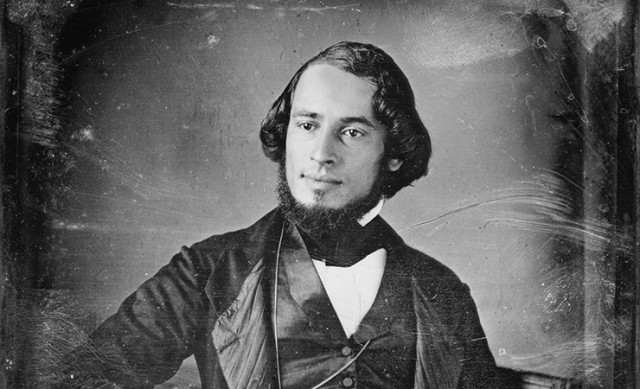
 The extraordinary story of nineteenth-century Jewish-American Renaissance Man Solomon Nunes Carvalho is told in the beautiful documentary Carvalho’s Journey. Born in Charleston, South Carolina, the Jewish cultural center of the U.S. in 1815, Carvalho was a painter, daguerreotypist, inventor, philosopher, husband, father, and practicing Jew. In 1853, Mathew Brady recommended him to explorer John C. Frémont, who was looking for a photographer to document his fifth and final Westward Expedition. So Carvalho brought his bulky equipment and set out to do what no one had done before, take pictures of a vast and treacherous landscape, a journey that would risk the lives of everyone involved as Frémont searched for a railroad route through the Rocky Mountains. Along the way, Carvalho never lost sight of his faith and his deep love for his wife, Sarah Miriam, as evidenced by the detailed, poetic letters he wrote her in addition to his 1857 memoir, Incidents of Travel and Adventure in the Far West. “With few men, religion is a color, a lifeless, abstract notion, but abstraction is not pure religion. Religion must signify itself in our actions in life. Aye, it must embrace the whole sphere of our activities and affections,” Carvalho, voiced by Josh Hamilton in the film, wrote. Historian David Oestreicher explains, “He was very proud of who he was, but at the same time he was a proud American; he saw the promise of America. I believe that he was being a good American by exercising his right to openly belong to his people. I don’t think he saw a conflict there.”
The extraordinary story of nineteenth-century Jewish-American Renaissance Man Solomon Nunes Carvalho is told in the beautiful documentary Carvalho’s Journey. Born in Charleston, South Carolina, the Jewish cultural center of the U.S. in 1815, Carvalho was a painter, daguerreotypist, inventor, philosopher, husband, father, and practicing Jew. In 1853, Mathew Brady recommended him to explorer John C. Frémont, who was looking for a photographer to document his fifth and final Westward Expedition. So Carvalho brought his bulky equipment and set out to do what no one had done before, take pictures of a vast and treacherous landscape, a journey that would risk the lives of everyone involved as Frémont searched for a railroad route through the Rocky Mountains. Along the way, Carvalho never lost sight of his faith and his deep love for his wife, Sarah Miriam, as evidenced by the detailed, poetic letters he wrote her in addition to his 1857 memoir, Incidents of Travel and Adventure in the Far West. “With few men, religion is a color, a lifeless, abstract notion, but abstraction is not pure religion. Religion must signify itself in our actions in life. Aye, it must embrace the whole sphere of our activities and affections,” Carvalho, voiced by Josh Hamilton in the film, wrote. Historian David Oestreicher explains, “He was very proud of who he was, but at the same time he was a proud American; he saw the promise of America. I believe that he was being a good American by exercising his right to openly belong to his people. I don’t think he saw a conflict there.”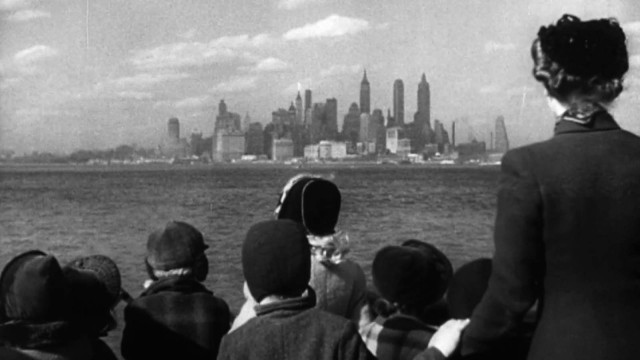
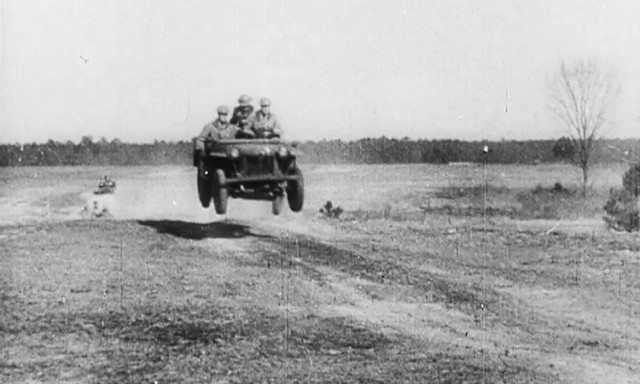
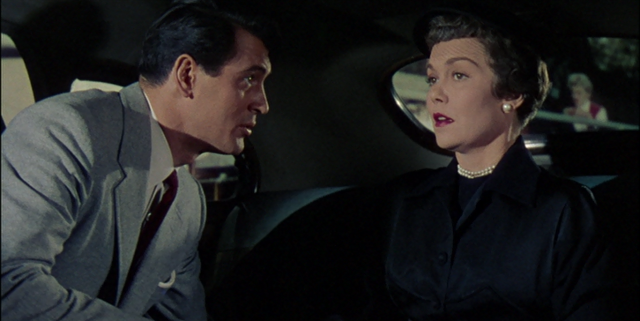
 Forget about It’s a Wonderful Life, Miracle on Thirty-Fourth Street, and endless versions of A Christmas Carol; our new favorite holiday movie is Douglas Sirk’s sensationally strange and beautiful All That Heaven Allows, and you can see it, along with the similarly sensationally strange and beautiful Magnificent Obsession, December 24 & 25 as part of the Film Society of Lincoln Center’s two-week, twenty-eight-movie retrospective “Imitations of Life: The Films of Douglas Sirk.” Released in 1954, Magnificent Obsession is a remake of John Stahl’s 1935 film, which starred Irene Dunne and Robert Taylor and was based on Lloyd C. Douglas’s book. In his breakthrough performance in the 1954 version, Rock Hudson is Bob Merrick, an errant playboy who gets seriously injured while recklessly racing his fancy speedboat. He is saved when the town’s only resuscitator is rushed over to him; however, it turns out that at the same time, a well-respected and beloved local doctor, Wayne Phillips, suffers a heart attack and dies because the resuscitator was being used for Merrick instead. Eventually riddled with guilt, Merrick attempts to befriend the doctor’s widow, Helen (an Oscar-nominated Jane Wyman), but only ends up making things worse when he helps cause an accident that blinds Helen. He then falls in love with her, which leads to a whole slew of other problems. The next year, Hudson and Wyman fell in love again in Sirk’s All That Heaven Allows. This time around, Hudson is Ron Kirby, a soft-hearted, hunky gardener who prefers a simple, outdoorsy life yet is drawn to Cary Scott (Wyman), an older widow who is firmly entrenched in her community’s country-club lifestyle. They begin a passionate affair but when they decide to wed, Cary’s children and the snooty members of the town’s social register are thoroughly appalled and do everything in their power to drive them apart because of class, wealth, and age differences.
Forget about It’s a Wonderful Life, Miracle on Thirty-Fourth Street, and endless versions of A Christmas Carol; our new favorite holiday movie is Douglas Sirk’s sensationally strange and beautiful All That Heaven Allows, and you can see it, along with the similarly sensationally strange and beautiful Magnificent Obsession, December 24 & 25 as part of the Film Society of Lincoln Center’s two-week, twenty-eight-movie retrospective “Imitations of Life: The Films of Douglas Sirk.” Released in 1954, Magnificent Obsession is a remake of John Stahl’s 1935 film, which starred Irene Dunne and Robert Taylor and was based on Lloyd C. Douglas’s book. In his breakthrough performance in the 1954 version, Rock Hudson is Bob Merrick, an errant playboy who gets seriously injured while recklessly racing his fancy speedboat. He is saved when the town’s only resuscitator is rushed over to him; however, it turns out that at the same time, a well-respected and beloved local doctor, Wayne Phillips, suffers a heart attack and dies because the resuscitator was being used for Merrick instead. Eventually riddled with guilt, Merrick attempts to befriend the doctor’s widow, Helen (an Oscar-nominated Jane Wyman), but only ends up making things worse when he helps cause an accident that blinds Helen. He then falls in love with her, which leads to a whole slew of other problems. The next year, Hudson and Wyman fell in love again in Sirk’s All That Heaven Allows. This time around, Hudson is Ron Kirby, a soft-hearted, hunky gardener who prefers a simple, outdoorsy life yet is drawn to Cary Scott (Wyman), an older widow who is firmly entrenched in her community’s country-club lifestyle. They begin a passionate affair but when they decide to wed, Cary’s children and the snooty members of the town’s social register are thoroughly appalled and do everything in their power to drive them apart because of class, wealth, and age differences.